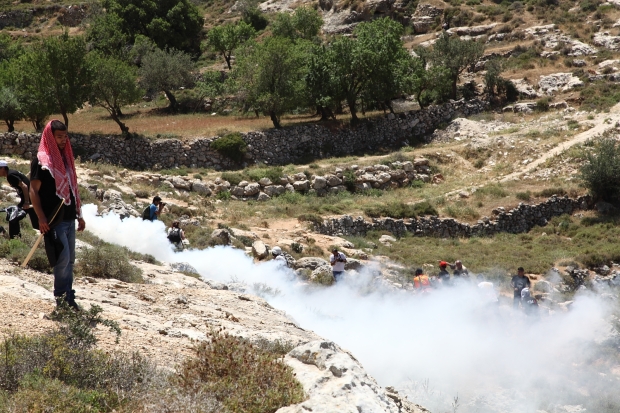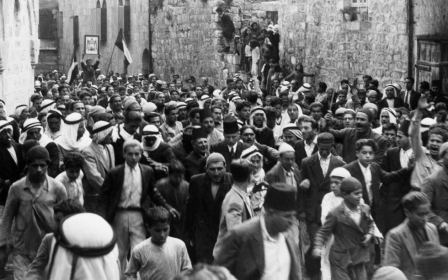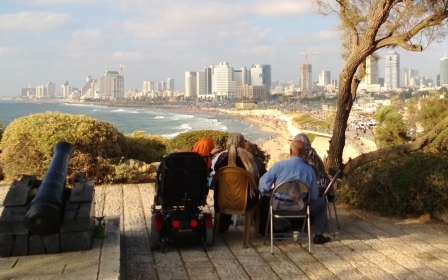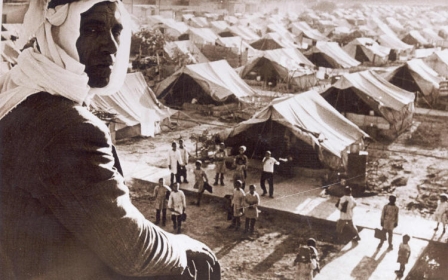The evolution of direct action in the struggle for Palestinian return
Nadim Nashaf is the Director of Baladna, a grassroots Palestinian organisation based in Haifa. Having worked with Palestinian youth for many years, Nashaf believes that for today's young activists 'commemorating' the Nakba is not seen as a proactive step towards the realisation of inalienable Palestinian rights. Instead, they are developing new forms of struggle.
"Commemorative Nakba-related events have traditionally been used to retain and develop the connection to land and sustain memory, but the new generation feel that for them this is not enough. They see direct action as a necessary tool towards the realisation of rights," he said.
The right of return for displaced Palestinians, including refugees and Internally Displaced Persons (IDPs) is fundamental within the Palestinian body politic and is supported legally both within United Nations resolutions and various other human rights instruments. There continues however, to be a lack of tangible political will to implement the right of return which continues to be considered as an 'obstacle' to peace in the international framework. This lack of political will is amplified by a growing distrust in the Palestinian street of the national leadership. Nashaf feels that this is also playing a significant role in the development of new tools of struggle by activists:
"The PA sends either direct or indirect messages that they are giving up on the right of return. Abu Mazen [Palestinian president Mahmoud Abbas] makes speeches which don't represent our rights and the new generation are using social media to reject this. The PA is disconnected from Palestinian reality so activists are responding with new methods of organising using direct action within non-hierarchical structures to create new forms of popular activism," he added.
New MEE newsletter: Jerusalem Dispatch
Sign up to get the latest insights and analysis on Israel-Palestine, alongside Turkey Unpacked and other MEE newsletters
Nakba Day 2011
Palestinians took a collective and pro-active step in 2011 which could be seen as a cornerstone of these recent developments. For many years, mass commemorative Nakba Day marches had taken place in Ramallah and Gaza as well as inside what Palestinians refer to as '48 Palestine, current day Israel. As Nakba Day 2011 started to take shape, huge numbers of refugees in surrounding Arab countries headed towards the borders declaring their collective intention to implement their right of return. On the Lebanese and Syrian borders, refugees amassed and attempted to physically cross borders to reach their villages. Several refugees ran through Israeli-laid minefields on the Lebanese border and reached the border fence. From the Syrian side, many succeeded in crossing the border and reaching the town of Majdal Shams in the occupied Golan Heights. All but one of those who reached Majdal Shams were either arrested by Israeli forces or returned to the border themselves. The one exception was a 28 year old refugee who after visiting his family home in Jaffa turned himself in to the Israeli police identifying himself as 'Hassan Hijazi from Jaffa'. He was later returned to Syria by the Israeli authorities.
The Israeli response on the borders to these unarmed refugees was violent, leading to the deaths of 11 refugees on the Lebanese border and 4 on the Syrian border. Hundreds were injured. In Jordan and Egypt planned actions were thwarted by domestic security services. Inside the occupied Palestinian territories, Palestinians also marched collectively towards Israeli checkpoints. More than 200 were injured throughout the day and in Gaza two Palestinians were killed. Organisation for these collective events had included the use of social media networks in the preceding weeks.
Implementing 'Return'
Nakba Day 2012 saw Israel close checkpoints across the West Bank and prevent large numbers of buses reaching Ramallah and Qalandia checkpoint which had been the site of a 'return march' the previous year. Israel had generally not impeded the Ramallah event on a large scale previously, in the belief that a 'commemorative' event in the centre of Ramallah presented no challenge - either physically or politically - to the status quo, but the 2011 rights-based activism towards borders had created a wave of bad publicity internationally to the Israeli response and in its itself attempted to directly challenge Israeli hegemony.
In the summer of 2012, a group of IDPs from the village of Iqrit further developed this new wave of direct action. For several years annual youth summer camps had been staged by the displaced community in Iqrit and other villages in the north including Kufr Bir'im. Following Iqrit's 2012 summer camp, a group of youth announced the decision to remain in their village and implement their return. The group stayed in the village church which they had renovated during previous summer camps. All other buildings in the village had been entirely destroyed in 1951 by the Israeli army, three years after the forcible depopulation of the village by Zionist militias.
By living in the village church the 'returnees' presented a challenge to Israel - was the state prepared to attack a church within the State of Israel and physically remove people from it? The answer to date has been 'No', although attempts to construct anything outside the church, including chicken coups, have been met by immediate demolition. In nearby Kufr Bir'im, a similar action was implemented following their 2013 summer camp, again youth-led but this time with a wider cross-section of the entire displaced community actively involved in the actual 'return'. Bir'im's returnees further developed the model when they strategically refused to inhabit the church in their village, instead setting up an encampment of tents alongside the church.
Wassim Ghantous is a third generation IDP and amongst the 'al-Awda' youth group that forms the core of returnees in Bir'im. Ghantous believes that several factors led to the decision to implement their return in this manner:
"The exclusion of Palestinian citizens of Israel from the PLO's political discourse - by signing the Oslo accords and labelling us an 'internal Israeli issue" - pushed us to take our struggle into our hands. This, combined with the dead end of domestic jurisdiction and the increasing institutional exclusion and racism towards Palestinians in Israel, makes return virtually impossible. So we saw that rather than a reactionary position 'appealing' for return and 'waiting' for it, we needed to adopt tactics of direct action to implement it."
Using non-hierarchical structures of organising, the returnees in Kufr Bir'im and also Iqrit are rejecting the current hierarchy at the root of the Palestinian national movement and trying to create a real popular alternative.
The return camp in Bir'im was soon issued with an evacuation and demolition order and returnees began a legal challenge to these orders, although Ghantous says this was to 'buy time for strategising rather than in the belief that the Israeli legal system would offer us any kind of justice'. This ongoing legal case is not a substitute for direct action as the returnees have remained in Bir'im as it continues.
Various other displaced communities in the north of 1948 Palestine implemented summer camps in their home villages in the summer of 2013 and collective strategising continues amongst these communities with a view to developing this model on a wider scale.
Return March to Lubya
Returnees from Kufr Bir'im and Iqrit were amongst more than 10,000 Palestinians who attended a 'Return March' to the depopulated village of Lubya on May 6th 2014. The annual Return March for IDPs has been held since 1998 and this year’s event attracted the largest attendance to date. The Israeli state permits these events as it attempts to hide under its rapidly collapsing veneer of democracy, on the understanding that no-one will remain in the villages after the marches. A heavy Israeli 'security' presence was evident, but no violence was used against attendees.
Baladna's Nashaf saw the influences of the new structures of activism on this year’s event.
"In Lubya, social media was used by the internally displaced youth who sent messages and live images to refugees in Yarmouk camp in Syria. The refugees in Yarmouk responded with photos of themselves holding banners supporting the activists in Lubya. This was really amazing. Such actions are growing on a popular level. Non-hierarchical grassroots movements are more difficult to organise but are also more democratic. We need to develop more of these cross-border link-ups between our people," said Nashaf.
Nakba Day in al-Walaja
Building on the model of 2011, community-based organisations and grassroots movements in the Bethlehem area worked collectively in the lead up to this year's Nakba Day to organise the latest action against Israel's settler colonial project. Amongst the organisations involved was BADIL Resource Center for Palestinian Residency Refugee Rights. On May 13th, BADIL's Director Nidal al-Azza described the planned event.
"This year's Nakba Day in al-Walaja will include a photographic exhibition produced by female activists and then we will attempt to reach and cross the Green Line because our villages and land are there," said al-Azza.
According to UNRWA statistics, approximately 70% of al-Walaja's lands were colonised in 1948, and its residents became refugees. Some villagers fled to Jordan, others ended up in refugee camps within the West Bank, yet a few villagers constructed new houses within al-Walaja's remaining lands as the Green Line bisected the village. Nearly half of these remaining lands were then annexed within Israel's 'Greater Jerusalem' project after 1967. Settlement construction then began as Gilo and Har Gilo were developed on the lands of al-Walaja and neighbouring villages. Since 2006, the seprati and military roads have been eating away at the tiny pieces of the village that remain.
At the top of a hill overlooking the Green Line in al-Walaja a tent was erected on Nakba Day which housed the photographic exhibition produced by female activists. By mid-morning, more than 1000 activists from Bethlehem, its camps and the wider southern West Bank area had congregated. Down the hill, a small number of Israeli military jeeps could be seen on the military road behind barbed-wire sections of the separation barrier system. As activists headed down the hill, the IOF seemed surprised and were unable to prevent activists opening-up the barbed wire and passing this latest 'border'. Activists flooded the military road as IOF reinforcements and Israeli police hurried to the scene. Some activists continued towards the Green Line whilst others were overcome with barrages of tear-gas forcing them down the road or back through the dismantled wall. Over the following hours, the dry hills of al-Walaja echoed under the sounds of violence and resistance - women sang national songs as the IOF bombarded the area with tear-gas. Amidst all this, a very small group of activists passed across the road and headed to the 1948 occupied lands.
As the majority of activists were forced back up the hill to the tent under heavy clouds of tear-gas the atmosphere was defiant. Local member of the Popular Resistance Committee, Munder Amira, himself a refugee from Beit At'ab, saw the event as a small victory in the ongoing struggle:
"Dedicated actions are needed to struggle for rights. Today we broke fences and entered '48. We showed that we will not accept imposed boundaries or borders," he said.
The IOF later pushed deep in to the new village of al-Walaja and surrounded the activists' tent. Unsurprisingly, the tent met the same fate as Palestinian houses have been doing for more than 66 years when it was demolished by the Israeli forces.
On the same day, many amongst the new generation of activists in the central West Bank rejected the traditional ‘commemorative’ rally in Ramallah and instead went to either Ofer Prison or Qalandia checkpoint. At the Ofer demonstration, the IOF responded with lethal violence killing two young activists and injuring many others. Similar protests broke out in other locations across the 1967 occupied lands. By the end of the day, hundreds had been injured by Israel’s violent response.
One People, One Struggle
Palestinians are one collective, yet displaced and dispersed people. This fact is denied by Israel at the state level, using terminology such as 'Arab Israelis' or 'Arab citizens of Israel' to describe Palestinians citizens of the state including IDPs. That said, the Israeli state has developed policies under various guises, that may sometimes be used differently depending which Palestinian people they are enforced against, but the end result remains the same. Both refugees and IDPs continue to live in enforced exile yet IDP's can sometimes be 'permitted' to visit their homes - such as the Return March to Lubya - as long as they don't stay there. When refugees try to do the same - such as border crossing attempts in 2011 and 2014 - they are met with violence. The end result and the formulated Israeli goal - sustaining the colonial project – remains constant.
The ongoing Nakba currently sees displacement projects being implemented against Palestinians from the Galilee to the Naqab and from Jaffa to the Jordan Valley in which slightly different methods may be applied depending on whether the victims are 'citizens of the State of Israel' or ‘residents’ of 1967 occupied lands. In practice, despite Israeli claims to the contrary, the state-imposed tools, with their variable applications, also acknowledge the collective nature of the Palestinian people. These are seen as fundamentally colonial policies that are enforced with goals that are not dictated by the specific ID cards that Palestinians hold, but simply because they are Palestinian.
Within this context, new forms of Palestinian struggle are emerging, and many involved believe that only through a collective national and international anti-colonial struggle can rights finally be realised, as BADIL's Nidal al-Azza pointed out amidst the tear-gas in al-Walaja.
"Return is not a 'hope', but rather a right that must be enforced. Nakba is not a 'memory', but a continuing process. Our resistance must develop, and directly and collectively challenge the existing settler-colonial system," stressed al-Azza.
- Rich Wiles is an award-winning photographic artist, author and film-maker who has been based in Palestine for more than 10 years. His latest book is Generation Palestine: Voices from the Boycott, Divestment and Sanctions Movement (Pluto, 2013). www.richwiles.com
Photo: A Nakba survivor celebrates his 77th birthday back in Kufr Birim, nearly 66 years after he was forcibly displaced from the village. All photos courtesy of Rich Wiles
Middle East Eye delivers independent and unrivalled coverage and analysis of the Middle East, North Africa and beyond. To learn more about republishing this content and the associated fees, please fill out this form. More about MEE can be found here.






